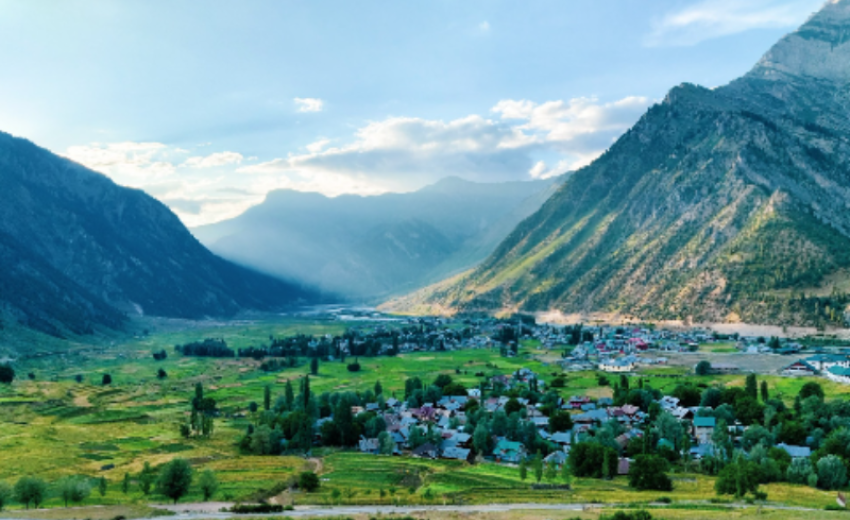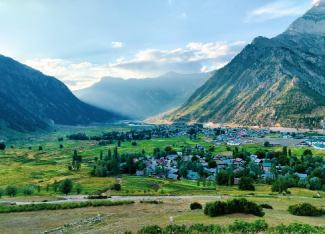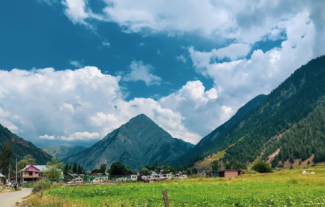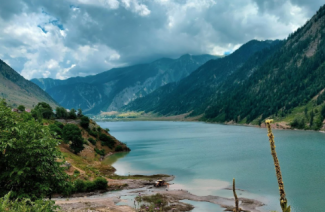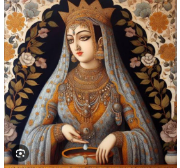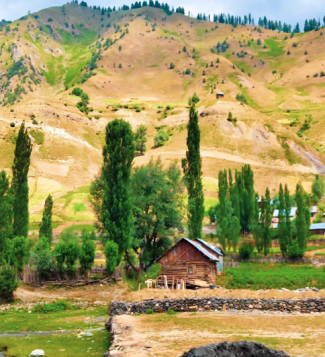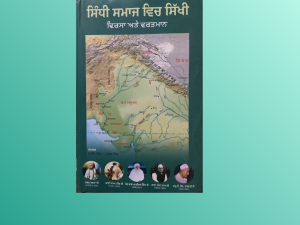Traveling from Srinagar to Gurez Valley by car is a journey that offers a rich tapestry of historical and cultural experiences through the beautiful landscapes of Kashmir. This route covers several key towns, each with its own unique historical background.
(Gurez Valley) Srinagar is the summer capital of Jammu and Kashmir and is renowned for its beautiful gardens, lakes, and houseboats. Founded by King Pravarasena II around 150 CE, it has been a significant center of political and cultural activities through various dynasties, including the Mauryas, Kushans, and Mughals. The city is also known for its historic Jamia Masjid, Shankaracharya Temple, Gurdwara Chhetti Patshahi and Mughal gardens such as Shalimar Bagh and Nishat Bagh.
At 7:30 AM, we embarked on our journey from Srinagar towards Gurez.Along the route, the verdant fields of paddy in Shadipura were flourishing, presenting a captivating spectacle. The vastness of Manasbal Lake at the foothills was offering an enchanting view. The surrounding areas of Safapura and Sadarkoot Bala were adorned with extensive paddy fields and abundant trees, presenting a picturesque scene.Thereafter, we passed through the village of Ajas, which is situated at the base of the mountains.Before reaching Bandipora, we paused to admire the captivating view of the vast Wular Lake on the left.In this lake, colorful birds appeared eager to play a special role. Bandipora is the first major town we encounter en route to Gurez. Historically, Bandipora has served as a trading and administrative center. It is located near the Wular Lake, one of the largest freshwater lakes in Asia, which has been crucial for local fishing and agriculture. The town has roots tracing back to ancient Kashmir, and it has been influenced by various rulers, including the Mughals, Sikhs and Dogras.The ascent begins from Bandipora. Through the dense forests, we reached Tragbal, situated at an elevation of 9, 613 feet, with the road winding like a serpent.Here, the Indian Army verifies identification cards and grants permission to proceed further. Passing through small villages and observing the divine beauty of nature, we arrived at a place called Razdan Top.This is an open mountain peak. Below it, only those trees grow whose bark was used to make paper in ancient times, known as birch bark. The branches of these trees appear white from a distance.
Razdan Pass, also known as Razdan Top, is a high mountain pass at an altitude of about 3,300 meters (10,827 feet). It serves as a gateway between the Bandipora district and the Gurez Valley. Historically, this pass has been a vital link for trade and military movements between the two regions. The area around Razdan Pass is known for its breathtaking views and strategic importance. Kanzalwan is a small village located along the Kishanganga River. Historically, it has been an important point in the valley due to its location along the ancient trade routes that connected Kashmir with Central Asia. Kanzalwan and its surrounding areas have seen various historical influences, from ancient Hindu and Buddhist periods to Islamic rule.Crossing the Badra stream, Kanzalwan, just before it, on the right side across the river, there is a memorial for Sikh soldiers. These soldiers were martyred in 1948 in extreme cold and snow while driving out Pakistani tribesmen from Gurez. The Indian Army should establish a historical monument at this location.
Dawar is the central town in Gurez Valley and serves as the administrative headquarters of the valley. Historically, Gurez Valley, and Dawar in particular, has been part of the Dardistan region, inhabited by the Dardic people. The area has a rich history of interaction with the neighboring regions of Gilgit and Baltistan. Dawar has been a significant settlement due to its strategic location on the ancient Silk Route, facilitating trade and cultural exchange.
(Habba Khatoon Hill) Gurez Valley itself, historically known as "Gorais," has been a significant region due to its strategic location. The valley was an essential part of the ancient trade routes connecting Kashmir with Gilgit and the rest of Central Asia. The inhabitants, known as the Dards, have a distinct culture and language. Gurez has been mentioned in the records of various travelers and historians, including Al-Biruni and Kalhana, who wrote about its beauty and strategic importance. This journey not only provides a scenic drive through some of Kashmir's most beautiful landscapes but also offers a deep dive into the historical and cultural layers of the region, making it a truly enriching travel experience.
The Kishanganga River, also known as the Neelum River in Pakistan, is a significant tributary of the Jhelum River, flowing through the Kashmir region of India and Pakistan. Originating in the Indian-administered territory of Jammu and Kashmir, it traverses the challenging terrain of the Himalayas before entering Pakistan-administered Kashmir. The river spans approximately 245 kilometers, supporting diverse ecosystems and human settlements along its course. Historically, it has been a vital water source for agriculture and sustenance in the region. The Kishanganga Hydroelectric Plant, a major infrastructure project, underscores its economic importance. Disputes over water usage and territorial claims have also made it a focal point in Indo-Pakistani relations.
(River KishanGanga) In the evening, we reached the Spring of Habba Khatoon, located four kilometers from our hotel, at the base of Habba Khatoon’s mountain. Not far from this spring, there is a cave where Habba Khatoon used to reside and where she would fill her pitcher with water from the spring. It is said that her pitcher broke this very spring. The water of this spring is exceptionally cold and sweet. Then we visited a beautiful Shina Cultural Centre (Shinon Meeras) that was brought by the Indian Army. After that we reached Khandyal Top, where a beautiful, picturesque view of Gurez Valley was seen. Habba Khatoon, also known as Zoon (which means "moon" in Kashmiri), was a 16th-century Kashmiri poet and queen. She was born in the village of Chandahar in Pampore, Kashmir. Her birth name was Zoon, and she was later known as Habba Khatun after her marriage. Habba Khatoon was born around 1554 into a peasant family. She received a basic education, which was uncommon for women of her time. Her early poetry reflected the natural beauty of Kashmir and her personal experiences. Habba Khatoon was married to a local peasant, but the marriage was unhappy due to her husband's disapproval of her poetic inclinations. She later met Yousuf Shah Chak, the king of Kashmir, who was captivated by her beauty and poetic talent. Yousuf Shah Chak married her, and she became the queen of Kashmir.
(Habba Khatoon) As queen, Habba Khatoon continued to write poetry, which became an integral part of Kashmiri literature. Her verses, often set to music, expressed themes of love, loss, and the beauty of nature. She is credited with introducing the "Lol" style of poetry in Kashmiri, which is characterized by its lyrical and emotional quality. Habba Khatoon ‘s poetry is distinguished by its simplicity and emotional intensity, contributing to the foundation of the Kashmiri literary form known as "Ruf." Her works remain an integral part of Kashmiri cultural heritage, celebrated for their melodic beauty and profound emotional resonance, continuing to inspire and comfort generations of Kashmiris.
Habba Khatoon's life took a tragic turn when Yousuf Shah Chak was captured by the Mughal Emperor Akbar and exiled to Bihar in 1586. After her husband's exile, she wandered the valleys of Kashmir, composing poignant verses that reflected her sorrow and longing. Her poetry from this period is filled with themes of separation and exile. Habba Khatoon is remembered as one of the most influential poets in Kashmiri literature. Her work has been preserved and passed down through generations, often sung as folk songs. She is celebrated for her contributions to the cultural and literary heritage of Kashmir. Habba Khatoon's life and poetry continue to inspire, symbolizing the resilience of the human spirit and the enduring power of artistic expression. One of her poems is as:
All my sorrows will vanish if you call on me Love, I will lay down my life for you. Sumptuous feast and delicious drinks I have kept ready for you. I will crown you with sweet garlands; My silvery self I will scour with cream; I am uneasy and pining for you; I will bathe in water of sandal-wood fragrance; My Love, I will lay down my life for you. Like the moon sinking down the ridge I stagger while my heart sinks in despair. Where comfortably, unconcerned are you asleep? Come, I will lay down my life for you! The cat is ready to pounce on the bird. So is Death waiting for a mortal Come, I have surrendered all to you; My Love, I will lay down my life for you! What great horror made you flee from home? And you did not rest even for a night. Habba Khatoon has ventured thus to say. My Love, I will sacrifice all for you!”
(Tulail Village) (Photo Credits: Taranjot Singh Sarna). Next day, we marched towards Tulial Valley, fifteen Kms, a picturesque sub-valley of Gurez, known for its pristine beauty. The Gurez Valley is known for its stunning natural beauty, including lush green meadows, the Kishanganga River, and snow-capped mountains. It's a remote and serene area, offering a glimpse into traditional Kashmiri culture and lifestyle. The village and the valley are relatively less explored, making them ideal for those seeking tranquility and unspoiled natural landscapes. Tulail Village is renowned for its stunning natural beauty, featuring lush green meadows, clear streams, and majestic snow-capped mountains. The Kishanganga River flows through the valley, adding to its picturesque landscape. Its secluded location makes it a peaceful retreat away from the hustle and bustle of city life. The village offers a glimpse into traditional Kashmiri culture and lifestyle. The residents of Tulail, primarily from the Dardic ethnic group, have preserved their unique customs, language, and way of life. Despite its remote location, Tulail and the Gurez Valley have significant potential for tourism. Adventure enthusiasts and nature lovers are particularly drawn to the area's pristine environment, trekking opportunities, and unspoiled beauty. Reaching Tulail Village can be challenging due to its remote location and the rugged terrain of the Gurez Valley. The main access route is via the Razdan Pass, which is often closed in winter due to heavy snowfall, limiting access to the village during certain months.

